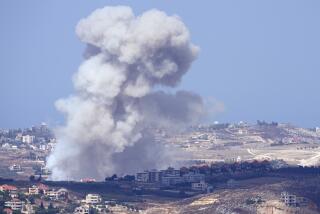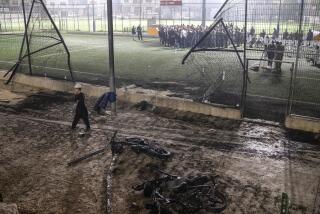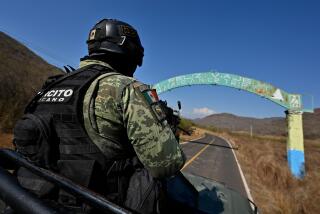Silent Peril Lies in Wait for Afghanistan’s People
KALAKAN, Afghanistan — More than two weeks after the last U.S. cluster bomb struck Taliban troops in this front-line village, lethal bomblets still litter the dirt paths and fields, lying in wait for farmers coming home.
Some are hidden in shallow holes, under bits of rubble, or partially buried in the soil, like one bomblet that fell beside a narrow path with all but its parachute covered by dirt.
At first glance, the parachute looks like just another piece of trash, the sort of thing a child might try to pick up or an adult could step on. That is what a returning villager did around 7 a.m. last Sunday.
He was one of two men who had come from Kabul, about 12 miles to the south, to visit their ruined homes and fields. The bomblet exploded, killing him and wounding a companion.
The U.S. has dropped about 600 cluster bombs in Afghanistan since the war began. Each bomb disperses 202 bomblets the size of soda cans. Judging from past military campaigns, at least 5% of the bomblets landed without exploding, leaving about 6,000 potential death traps on the ground.
Scattered deaths and injuries among Afghan civilians have sparked renewed controversy over the cluster bombs, which strategists value as a devastating weapon against massed enemy troops, despite the toll they exact among noncombatants.
“Clearly, cluster bombs have shown to be a greater hazard to civilians than virtually any other weapon that is legal,” said William Arkin, a former Army intelligence analyst who has studied the bombs.
Relief workers, physicians and former military officers, among others, say cluster bombs can be just as dangerous to civilians as land mines and should warrant the same international scrutiny. Land mines are banned by many countries, though not the United States.
Unexploded cluster-bomb canisters often penetrate loose soil, get stuck in trees, or fall into holes, where people accidentaly set them off long after a war is over. Unlike land mines, they can’t be sniffed out by dogs; the slightest contact with the animal’s nose can set the bombs off.
In Afghanistan, the bomblets are yellow, the same color as food packets dropped by warplanes, adding to the peril and controversy.
U.S. fighter jets dropped their first cluster bombs Oct. 26 on reinforced front lines of Taliban troops at the strategic northern crossroad of Mazar-i-Sharif. The Pentagon says the bombs helped opposition fighters capture their first major city.
“The place to best use them is in an area that would have minimal collateral damage impact and maximum numbers of forces that you would wish to kill,” said Rear Adm. John D. Stufflebeem, deputy director of operations for the Joint Chiefs of Staff.
The triangular parachutes are designed to inflate as the bomblets fall. They are supposed to help disperse the bomblets over a wide area and slow their descent so that they hit the ground at the proper angle to explode on impact.
Experts say the bomblets often don’t explode in sand, snow and mud. The high altitude from which the larger cluster bombs are dropped and wind conditions can increase the number of bomblets that land without detonating, said Peter Le Sueur, an expert on clearing mines and unexploded ordnance in Afghanistan.
“From Laos to Lebanon, from Kuwait to Kosovo, hard experience teaches that unexploded cluster bomblets pose enduring risk to civilian populations,” said Virgil Wiebe, a University of Maryland visiting law professor who has researched cluster bombs.
In Laos, where the U.S. dropped tons of the bombs during the Vietnam War, there are fresh reports of cluster bomb casualties even now, three decades later. Most of the victims are children.
What makes the bombs an effective military weapon--the bomblets can spread over an area as large as three football fields--also makes them hazardous to civilians.
To enhance their accuracy, the Defense Department has retrofitted about 450 of the cluster bombs dropped in Afghanistan with wind-correction tail kits. The special device corrects the bomb’s course at high altitudes.
But witnesses on the ground say bomblets nevertheless have landed in civilian areas.
On Tuesday, one apparent cluster bomb rained over a semi-nomadic settlement known as Zar Karez, east of the north-south road between Kandahar and Pakistan.
Abdul Qadar, a 25-year-old shepherd, was eating a meal of buttermilk and bread when the bomb knocked him unconscious.
His brother, Abdul Nader, 30, described the scene: “The United States bombs were raining over the village,” he said. “The bomb divided into many, many bombs. They were spreading over a 400-meter area.”
The bomb left Qadar hospitalized with shrapnel wounds in his back and a severe wound in his pelvis that stained his rough cotton trousers with blood.
United Nations officials said this week that their workers had cleared undetonated cluster bomblets from 54 homes and a mosque in Qala Shater, a village near the western city of Herat. A 12-year-old boy blew off part of his arm in Herat, reportedly after picking up an unexploded cluster bomblet.
Humanitarian groups have said that whoever drops the bombs should be responsible for the cleanup. The U.S. has a different view. “Those responsible for the conflict should bear the burden of that,” said Maj. Mike Halbig, a Defense Department spokesman. “We’ve been quite clear that the people responsible for what is happening over there are Al Qaeda and the Taliban.”
But Halbig said the U.S. would work with Afghanistan and other countries “to reach a solution to this issue.” He noted that the U.S. has funded mine-removal efforts in Afghanistan since 1989.
Meanwhile, United Nations workers and other groups cleaning up mines left over from the conflict with the Soviets in the 1980s are trying to deal with the new unexploded cluster bomblets.
“The problem is these things will lay there dormant for years and years and years. After the good and bad guys leave, there are people that have to live, work and farm in these areas,” said retired Army Lt. Col. Gary Wright, who studied the deadly aftermath of cluster bombs in the Gulf War, where some experts believe 2 million unexploded bomblets were left in Iraq and Kuwait. “It’s a genuine mine field.”
Wrapping humanitarian food rations in the same color packets as the bomblets is a “tragic mistake,” said Jean Ziegler of Switzerland, a United Nations food official.
Although the Pentagon said it would change the color of the ration packages to avoid confusion with the bomblets, it hasn’t done so yet. U.S. radio broadcasts urge Aghans to “please, please exercise caution when approaching unidentified yellow objects in areas that have been recently bombed.” Unexploded bomblets also left a deadly legacy in Kosovo.
In a meeting last year with the All-Party Parliamentary Landmine Eradication Group in London, NATO officials said they dropped 1,392 cluster bombs and that an 8% to 12% failure rate “is supported by information on the ground,” according to notes of the presentation. The unexploded canisters had killed 47 people, including 24 children, in the year after the 78-day conflict ended. Another 101 people were injured, NATO reported.
The International Committee of the Red Cross found that children under the age of 14 were five times more likely to be killed or maimed by cluster bombs in Kosovo than by land mines.
Dr. Adam Kushner, 36, visited Kosovo in August 1999 to learn about the impact of land mines on civilians for a Boston-based group called Physicians for Human Rights. But he came away thinking that cluster bombs were even more of a hazard.
He saw an 8-year-old girl who lost two of her fingers when she approached “a bright colored object in some bushes.” He found a 23-year-old man who, while tending cows, hit a yellow object hanging in a tree with a stick. The ensuing blast sent the man to the hospital for three weeks.
“They were probably the lucky people,” Kushner said.
In a January 2000 “after-action report” on Kosovo for Congress, the Pentagon praised cluster bombs as an effective weapon, but acknowledged a “risk of collateral damage.” The report also said that there was a “need for early and aggressive unexploded-ordnance cleaning efforts” because of the danger to civilians.
Washington did not follow that advice. It took months for the U.S. to supply the United Nations with data on where cluster bombs were dropped in Yugoslavia. During the delay, dozens fell victim to the unexploded bomblets.
While hundreds of thousands of Kosovo Albanians were living in refugee camps in neighboring Macedonia and Albania, mine clearing agencies gave classes on what to watch out for when they returned home.
In Afghanistan, where communications are poor or non-existent, people have to rely on their own wits when confronted with weapons they haven’t seen before, such as U.S. cluster bomblets.
It is not clear how the man from Kabul set off the bomblet in Kalakan last Sunday. Khan Aqa, 39, a Northern Alliance soldier posted nearby on the main road, said the man stumbled on a rock and then stepped on the detonator at the top of the canister. Several villagers said they thought the man had picked up the bomblet and it exploded in his hand.
A man in his late 30s named Abdul Samad came running to the road for help, covered in blood from his own shrapnel wounds, said Aqa. Aqa hurried on one leg and crutches to the other victim. Aqa stepped on a land mine 17 years ago while fighting former Soviet Union troops occupying Afghanistan.
“When I reached the other victim, he was dying, gasping and losing his life,” Aqa said through an interpreter. “He couldn’t speak and died. We brought a bed and carried him from here.”
The bomblets bore black stencilled lettering--BLU 97 A/B--that identified them as American cluster bomblets. Each small canister packs three powerful weapons, said Tom Dibb, 33, the Central Asia desk officer for the Halo Trust, a British-based mine clearing agency.
Every bomblet contains an inverted copper cone, with an explosive charge behind it. The blast turns the cone “into a jet of molten copper, which then punches straight through armor,” as in the walls of a tank, Dibb said.
The bomblets are made with “fragmentation jackets,” which can penetrate lighter vehicles such as trucks. The third weapon is an incendiary charge, which creates a small fire when the bomblet explodes, Dibb added.
None of half a dozen villagers interviewed in Kalakan Wednesday amid the field of unexploded cluster bomblets criticized the U.S. for dropping them. It was good that the U.S. bombed the area because Arab fighters were based in the village, they said.
“They were right to drop the bombs and remove the Taliban,” said Abdul Samad, 23, a cousin of the blast survivor, who shares the same name. Samad blamed his cousin’s companion for not being more cautious. “If an innocent person thinks clearly, this bomb can’t hurt him.”
Nader, the brother of the shepherd wounded in the bombing of Zar Karez, offered a contrasting view.
“We do not understand why they did it. There are no Taliban here, only the nomadic people stay here and now we are gone,” Nader said.
Research from the Mennonite Central Committee, Landmine Action in London, the International Red Cross and Human Rights Watch has documented hundreds of civilian deaths around the world from cluster bombs.
“It is clear that at the present time, the use of even the most sophisticated cluster bombs poses grave and unacceptable dangers to civilian populations,” Human Rights Watch wrote in October. “There should be no further use until governments can establish that a solution is possible to the problems of bomblet dispersion and explosive duds -- be it a technical solution, new restrictions and requirements regarding use, or some combination of measures.”
So far in Afghanistan, the U.S. has been dropping CBU-87 cluster bombs, known to be inaccurate at high altitudes. The CBU-87 drops the kind of bomblets that littered the ground in Kalakan. The addition of the wind kits on some of the bomblets should help in targeting, but will not affect the failure rate, experts say.
“It’s ridiculous to argue that having a strap-on kit is going to make them substantially safer for non-combatants,” said Rae McGrath, a cluster bomb expert who has worked with Landmine Action in London. “Let’s put that to rest immediately.”
To affect the failure rate, the Air Force would have to install a battery within each bomblet to render it inoperable if it didn’t explode on contact, according to Jane’s, the weapons guide. Although such technology exists, it hasn’t yet been used by the U.S. on all its cluster bombs.
The same grassroots effort that helped ban land mines is now pushing for an intense international review of cluster bombs. Humanitarian groups hope the topic will be brought up in December at a review conference of the UN Convention on Inhumane Weapons in Geneva. Calls for self-destruct fuses on clusterbombs at past meetings have gone unheeded.
“I see a situation with cluster bombs that is very similar to the early days of the land mine campaign,” said McGrath, who urged the British House of Commons on Nov. 20 to conduct an “urgent and transparent debate” on cluster bombs.
For now, the United Nations, which is coordinating the clearing of land mines and unexploded ordinance from Afghanistan, has asked the U.S. for a map showing where cluster bombs were dropped, mine clearance workers said privately.
Dan Kelly, manager of the U.N.’s MineAction program, last month appealed for information from the U.S. about the type of bomblets used “so we can train our people and prevent further loss of human life,” he said.
The Kalakan cluster bomb field is one of three in southern Afghanistan that mine-clearing agencies know about so far. Halo Trust has heard of at least three more in northern Afghanistan and expects to find many more as its sappers spread across the country.
A team of Halo Trust sappers started work in Kalakan Tuesday, but so far they have only marked the danger areas with daubs of yellow paint on rocks. Mine clearing crews began special training Wednesday to learn how to detect and get rid of cluster bomblets, Dibb said in Kabul.
“Our teams have cleared literally hundreds of thousands of unexploded ordinance in Afghanistan, but these things pose a slightly different threat,” Dibb said. “And we need a special detector to do a sub-surface search for them.”
Halo Trusts’ sappers normally dispose of the bomblets by laying long fuses as close as possible and blowing them up from a safe distance. But Aqa, the veteran land mine victim, hasn’t waited for the experts, or special equipment. He has already cleared some of the U.S. cluster bomblets by hand.
“If you touch or move it from the sides, it won’t explode,” Aqa said, looking down at one of the yellow canisters. “I collected some from beside the road. If you say so, I will pick up one,” he added. No one took him up on the offer.
*
Watson reported from Afghanistan. Getter reported from Washington. Staff writers Alissa Rubin in Afghanistan, John Hendren and Robert Patrick in Washington, William Orme in New York and Peter Pae in Los Angeles contributed to this report.
More to Read
Sign up for Essential California
The most important California stories and recommendations in your inbox every morning.
You may occasionally receive promotional content from the Los Angeles Times.










